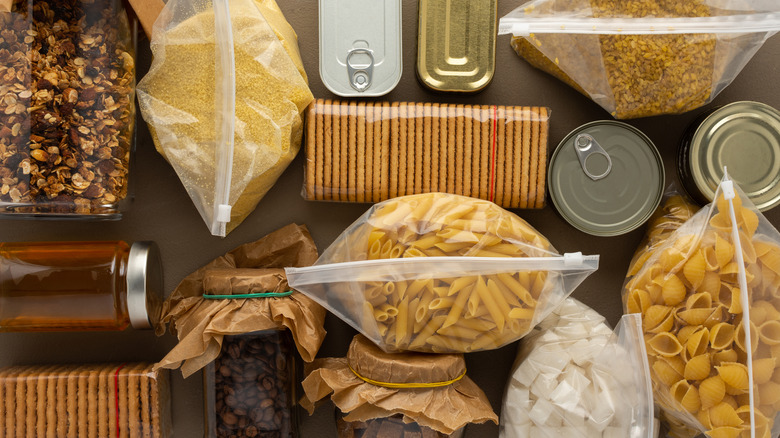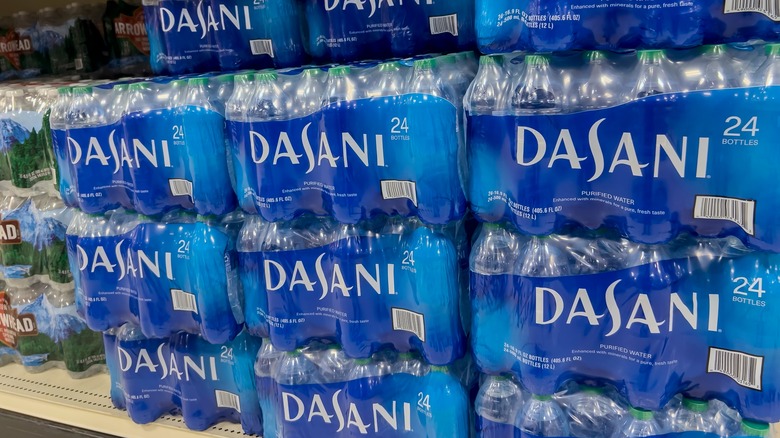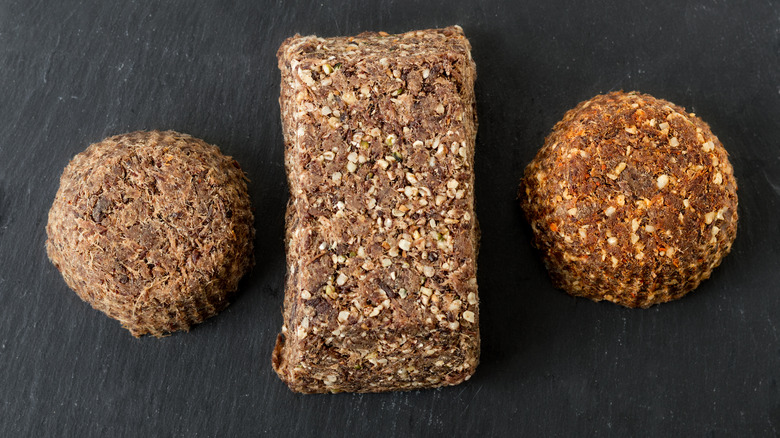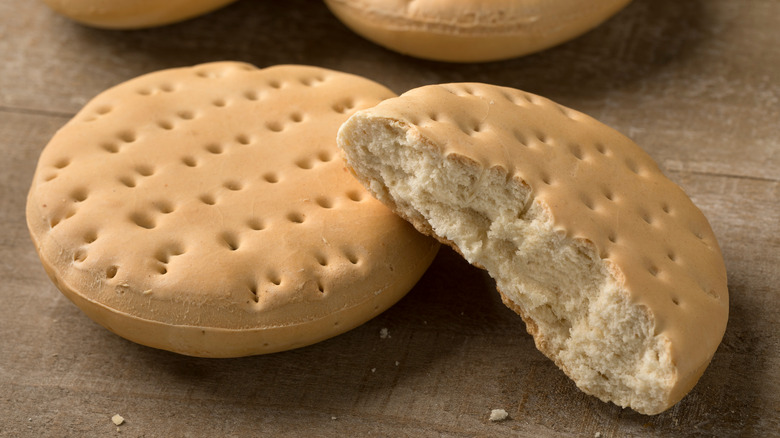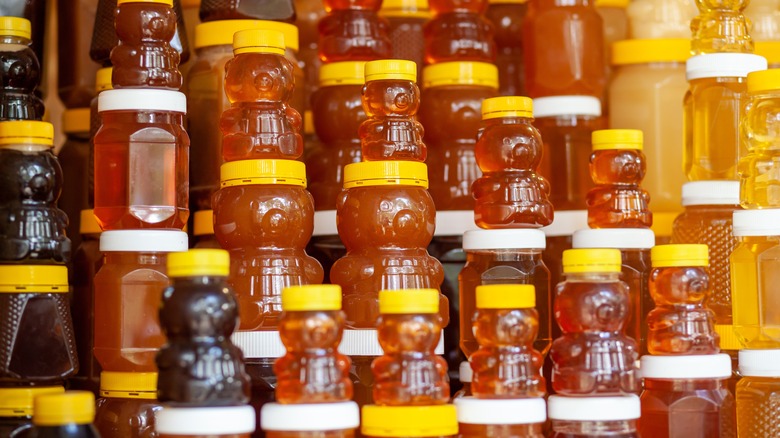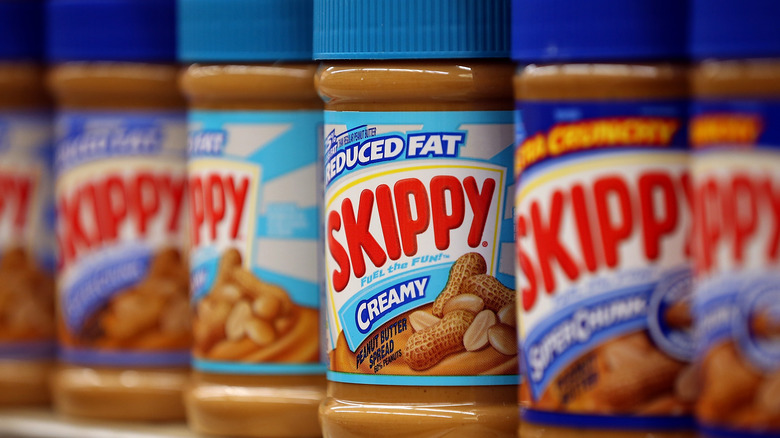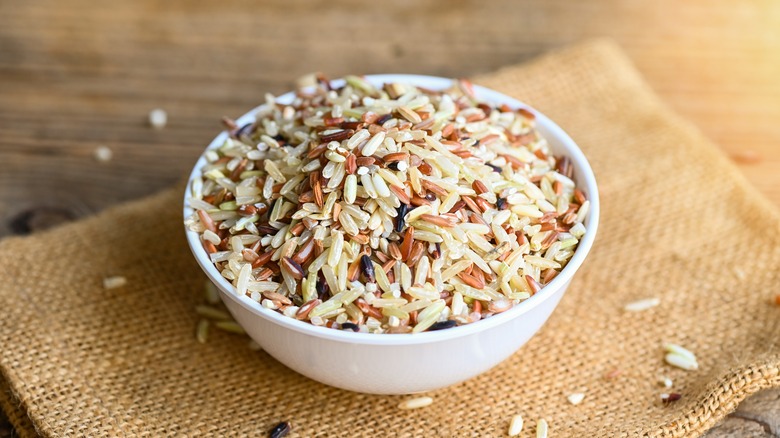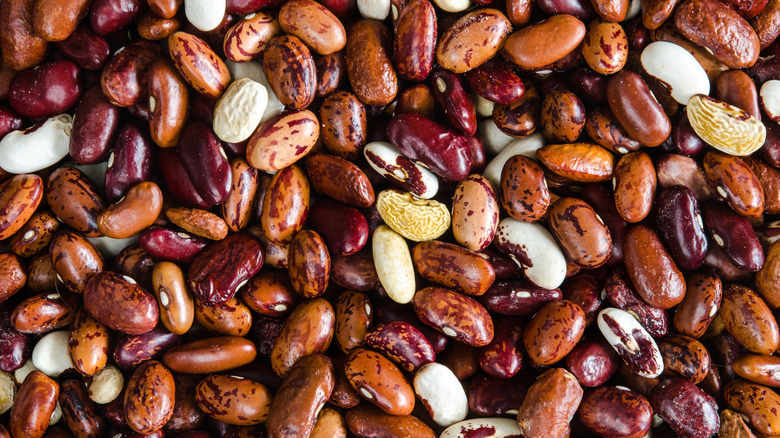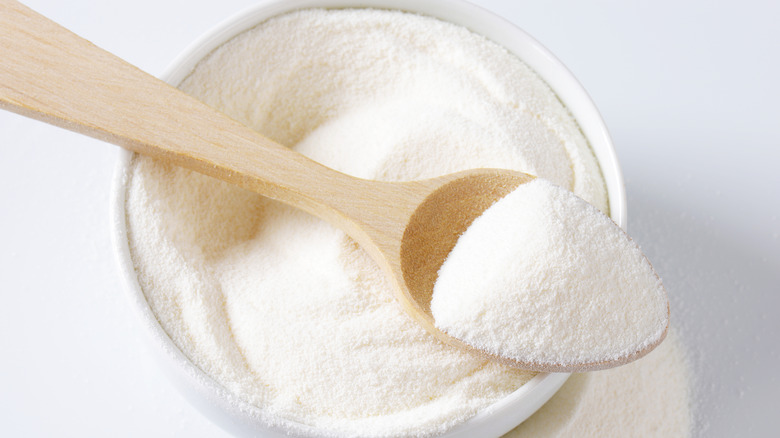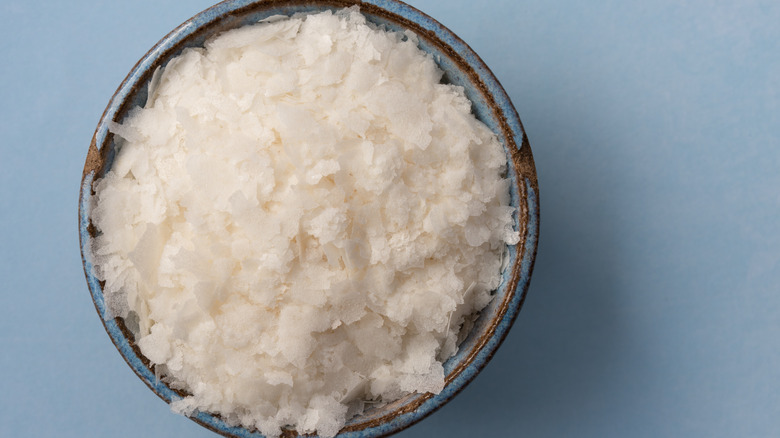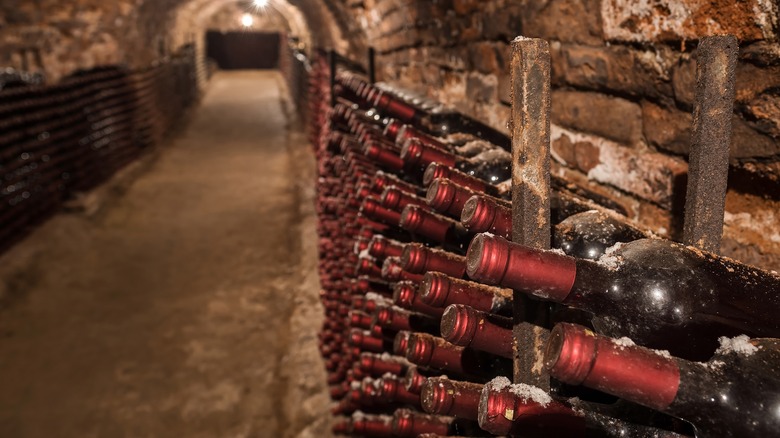12 Best Bomb Shelter Foods For The End Of The World
Just about every year, someone comes up with a new theory as to how the world's going to end. There was speculation that the world might end in 2000, with Y2K kicking off a string of apocalyptic events (per National Geographic). In 2012, folks put stock in a Mayan calendar supposedly predicting the end of the world (via NASA). Most recently, in early 2023, the Doomsday Clock — an indicator that scientists use to gauge impending, well, doom — was adjusted to indicate that we are now closer to "global catastrophe" than ever before, citing reasons such as nuclear threats and climate change (via USA Today).
Whenever you think the world may end, though, it doesn't hurt to be a little prepared. Even if you're not entirely sure whether the world will end in your lifetime, prepping for the future, even on a small scale, can ensure you have valuable resources on hand in the event of a local catastrophe, such as a natural disaster. So, no matter how big or small your bomb shelter is, whether you're planning an underground bunker or just a stockpile in the basement, here are some of the best bomb shelter foods to get you through the end of the world.
1. Bottled water
End of the world or not, bottled water is one of those things you need to have on hand. Water is the one item you can't live without (or, at least, not for very long). You can make it without coffee, wine, your favorite soda, and most foods, but water is non-negotiable. According to Healthline, while certain factors, such as environment and health, may impact just how long you can live without water, no matter the conditions, you can't live without water for more than a few days. At that point, severe dehydration starts to kick in and your organs begin to shut down and you die.
Since you're not going to last very long during the apocalypse without any water, take the Centers for Disease Control and Prevention's advice on how much emergency water you should have on hand. The organization recommends stockpiling store-bought, bottled water in quantities of a gallon of water per person per day.
The only bad bit? The CDC also says that if you're stockpiling non-store-bought water, you should replace your stockpile of water after six months. And if you're using storebought, it's important to pay attention to (and follow) the expiration dates. So it's not like you can start storing water away now and rely on it to last indefinitely. For a long-term solution, it's a good idea to learn how to sanitize drinking water on your own during less-than-ideal conditions (on that note, did you know you can purify water with banana peels?).
2. Pemmican
Move aside, beef jerky. When it comes to meat-based foods that can last a truly long time, nothing stands up to pemmican. As scientific journal Meat Science explains, pemmican is an ancient endurance food originally associated with Indigenous populations, though it has been adopted by others who see its value, including fur traders of centuries ago and modern military troops. Pemmican is known for lasting a long time under harsh conditions while providing a hefty amount of fuel in endurance-trying elements (this is why it was often considered a travel food — it's even been used by arctic explorers!).
So what exactly is it? Pemmican is made with a mixture of dried meat and fat. According to MasterClass, pemmican can last up to five years before going bad. While pemmican looks ... not all tasty, as it's just a dark brown, dehydrated lump ... the taste and texture are often described as similar to greasier beef jerky.
3. Hardtack
You probably know of hardtack as a long-ago, less-than-great-tasting food that was used on ship rides across the ocean, or as food eaten on battlefields under generally poor conditions. However, hardtack, as unpleasant as historical accounts sometimes make it seem, is actually a great end-of-world staple for the same reasons it remained popular throughout history.
As The Washington Post explains, hardtack is basically a cracker that's, yeah, hard. Hardtack is easy and cheap to make, with just water, flour, and salt. It lasts a long time. It hardens up until it's practically indestructible. Plus, once it's baked into cracker form, it can be carried around until you're ready to eat, at which point it can be turned into a mushy batter by breaking the cracker down and mixing it with water, coffee, or even whiskey. Historically, reluctant diners would fry this batter, or mix it with sugar, if available.
If you do decide to stockpile some hardtack, just make sure you have a heavy rock at the ready if you want to be able to break it down. It's called hardtack for a reason, so you'll need something sturdy to make a dent in this cracker.
4. Honey
Stock up on honey before the end of the world (or maybe take up a new hobby as a beekeeper) and you'll be glad you did. Not only does honey taste amazing (obviously) and can act as a sweetener during a time when you can't run to the store for a bag of sugar, but it also lasts a long time. In fact, it's known as one of the longest-lasting foods in the world, and it comes with some pretty impressive health benefits.
According to Southern Living, honey technically isn't perishable at all. With proper storage, honey will last decades. Sure, the texture and taste might not hold up, but it's still okay to eat. Furthermore, Mayo Clinic points to studies that show honey can potentially reduce the risk of cardiovascular disease, relieve a cough, reduce gastrointestinal distress, help heal burns, and even help with mental illness and memory disorders.
5. Peanut products
Looking for a tasty and nutritious snack to get you through the end times? You can't go wrong with peanuts or most peanut products. According to the National Peanut Board, a stockpile of peanuts will last you a good, long while. Unopened peanut butter can last up to nine months. Peanuts in unopened cans or jars can last up to two years. Unopened peanut flour, meanwhile, can last up to a year.
So what are you going to do with all those peanuts? You could combine them with your end-of-the-world honey, or add them to your hardtack ... or you could just eat your nuts and peanut butter straight. However you use them, you'll reap the benefits of eating peanuts regularly. For one thing, the National Peanut Board explains that eating peanuts daily can reduce cardiovascular disease risk. But even if you don't down the nuts daily, every time you grab a handful you're consuming important vitamins and minerals including vitamin E, magnesium, folate, copper, phosphorus, fiber, niacin, and manganese. Peanuts are also the most protein-rich nut.
6. Rice
A dietary necessity for billions of people, according to CGIAR, rice accounts for nearly 30% of the food consumed in many countries around the world, and there are so many reasons why rice should be part of your apocalyptic stockpile.
Rice is affordable. Rice is easy to cook (once you actually learn how to cook rice). You have lots of rice varieties to choose from and lots of different ways to cook it. You can steam it. Bake it. Throw it in a stew. Rice keeps you fueled up with carbs, but also includes vitamins and nutrients such as fiber and manganese (via Colorado State University).
If you want to add rice to your bunker stockpile, Utah State University recommends up to 60 pounds of rice per person per year. That said, the overall recommendation is to store about 300 pounds of grains per person per year. In other words, if you really like rice, you could make the argument for investing in up to 300 pounds of your favorite variety for yourself and each of your bunker mates.
7. Dried or canned beans
Dried and canned beans make a preferable emergency storage food for the same reasons that rice finds a place in the category. Beans are filled with nutrients and protein. They're cheap. They're easy to cook, and you have a lot of different options to choose from, whether you prefer black, pinto, kidney, white, or lima. The Northarvest Bean Growers Association points out that if you're looking for the best caloric bang for your buck, beans are an especially good pick, as you can get a pound of dried beans (delivering about 1,500 calories), for just a few dollars.
In storage, dried beans last for more than a year, though they might take a little extra cooking time the older they get. Canned beans, on the other hand, last for multiple decades. The key to keeping your beans fresh through the apocalypse, the Association says, is to keep them sealed, whether in the can or the bag, and in a dark spot.
8. Powdered milk
There will be no running to the convenience store for a gallon of milk once the apocalypse arrives. So how do you get your milk fix in the end times? Try powdered milk. According to Dietitians of Canada, powdered milk is long-lasting, cheap, and good for you — a suitable replacement for the real deal when you're in an end-of-the-world pinch. With multiple vitamins, calcium, and protein, powdered milk comes in bulk sizes in the baking aisle and can last up to a year in the pantry, unopened. More great news? Even after you open it up, it can last up to three years in the freezer (or three months in an airtight container on the shelf).
Other than rehydrating and drinking powdered milk, you can also use it for cooking and baking, and can even add it to other foods for its nutritional properties. Even if the world doesn't end tomorrow, you might want to dip into your powdered milk store and see why milk powder is a good choice for baking. It's known to give baked goods better textures and flavors in recipes where adding regular milk would create too much liquid.
9. Instant noodles
Instant noodles got you through college. Now they'll get you through the end times. Instant noodles may not be a food you can throw in your backpack and take on the run, like hardtack, but they're cheap, long-lasting, and easy to make with just some boiling water. Plus, they're tasty — way tastier than some of the other most-popular bomb shelter foods. As an NPR article notes, instant noodles appeal to people of all cultures as a blank slate on which one can paint a host of flavors. There are so many unexpected ways you can cook with instant noodles.
In terms of nutrition, instant noodles aren't going to cure apocalyptic scurvy, but they will fill you up and keep you full. The same NPR article points to instant noodles' glycemic index and high fat content, which, when combined, help make you feel full even when you've eaten less than a dollar's worth of food. Cooking the noodles into a soup likewise helps you stay fuller longer, thanks to the added water content.
10. Potato flakes
You're not going to lug around actual potatoes if you're on the move after an apocalyptic event (can you just imagine hiking around with a backpack full of spuds?). Likewise, you're not going to want to keep potatoes in storage for very long, as anyone who's found a long-forgotten bag of sprouted and rotting potatoes will tell you. However, you can still enjoy the deliciousness of mashed potatoes — and all the health benefits that come with them — at the end of the world, thanks to the magic of potato flakes.
Cheap, super-portable, and just requiring water to whip up, potato flakes come packed with fiber, potassium, and vitamin C (via LiveStrong). They also contain a lot of carbs, making you feel full and giving you extra energy. Even if you don't end up calling on potato flakes in an emergency, this is yet another food that you might want to keep on hand. Keeping instant mashed potatoes in the pantry means you've always got an instant thickener for soups and chowders, as well as an instant topping for a favorite casserole.
11. Wine
One thing you don't want to go without when the apocalypse hits? A good glass of wine. How else are you expected to wile away the time once there's no more internet? Of course, we can probably assume the liquor stores will be looted once things go down, so you'll need to learn to make your own eventually (you know, moonshine), but you can start building up your wine collection for the time being.
While a healthy wine collection will most definitely outlive you (unless you drink it first), Wine Enthusiast recommends drinking your wine in a certain order during the apocalypse as time goes on. You'll want to drink the stuff that's going to spoil faster and save the aged, longer-lasting stuff for later. That means the canned wine goes first, followed by everyday house wines. Moderate-acid whites and light reds go next, followed by moderate-acid reds and warm-climate wines. When you're getting close to about a decade post-apocalypse, you can start in on the cold-climate wines and vintage Champagne.
12. Fresh veggies (No, really!)
Don't think you have to give up fresh veggies during the apocalypse. While canned and dehydrated foods are king in terms of convenience and easy storage, if you prepare properly and live long enough in your bunker, you can grow your own produce in a bomb shelter. In fact, it's already being done.
As Popular Mechanics reported in 2020, a farm christened Growing Underground, has been established far beneath London in a reclaimed bomb shelter. There, the farmers grow all sorts of yummy fresh vegetables, from greens to broccoli to herbs. The plants are grown without soil or sun, but are kept safe from weather, weeds, and pests. The result is plants that grow faster and produce more overall food. Growing Underground delivers its subterranean crops to surrounding restaurants and other customers, showing that growing fresh food in your bunker is possible ... but you might want to start building your grow room now.
